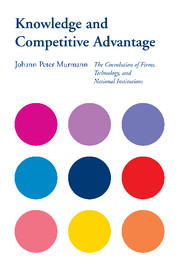Book contents
- Frontmatter
- Contents
- Series Editors' Preface
- Author's Preface
- Acknowledgments
- Timeline of Key Events in Development of the Synthetic Dye Industry before 1914
- CHAPTER 1 Introduction
- CHAPTER 2 Country-Level Performance Differences and Their Institutional Foundations
- CHAPTER 3 Three Times Two Case Studies of Individual Firms
- CHAPTER 4 The Coevolution of National Industries and Institutions
- CHAPTER 5 Toward an Institutional Theory of Competitive Advantage
- Appendixes
- Bibliography
- Index
- References
Bibliography
Published online by Cambridge University Press: 06 August 2009
- Frontmatter
- Contents
- Series Editors' Preface
- Author's Preface
- Acknowledgments
- Timeline of Key Events in Development of the Synthetic Dye Industry before 1914
- CHAPTER 1 Introduction
- CHAPTER 2 Country-Level Performance Differences and Their Institutional Foundations
- CHAPTER 3 Three Times Two Case Studies of Individual Firms
- CHAPTER 4 The Coevolution of National Industries and Institutions
- CHAPTER 5 Toward an Institutional Theory of Competitive Advantage
- Appendixes
- Bibliography
- Index
- References
Summary

- Type
- Chapter
- Information
- Knowledge and Competitive AdvantageThe Coevolution of Firms, Technology, and National Institutions, pp. 269 - 286Publisher: Cambridge University PressPrint publication year: 2003

